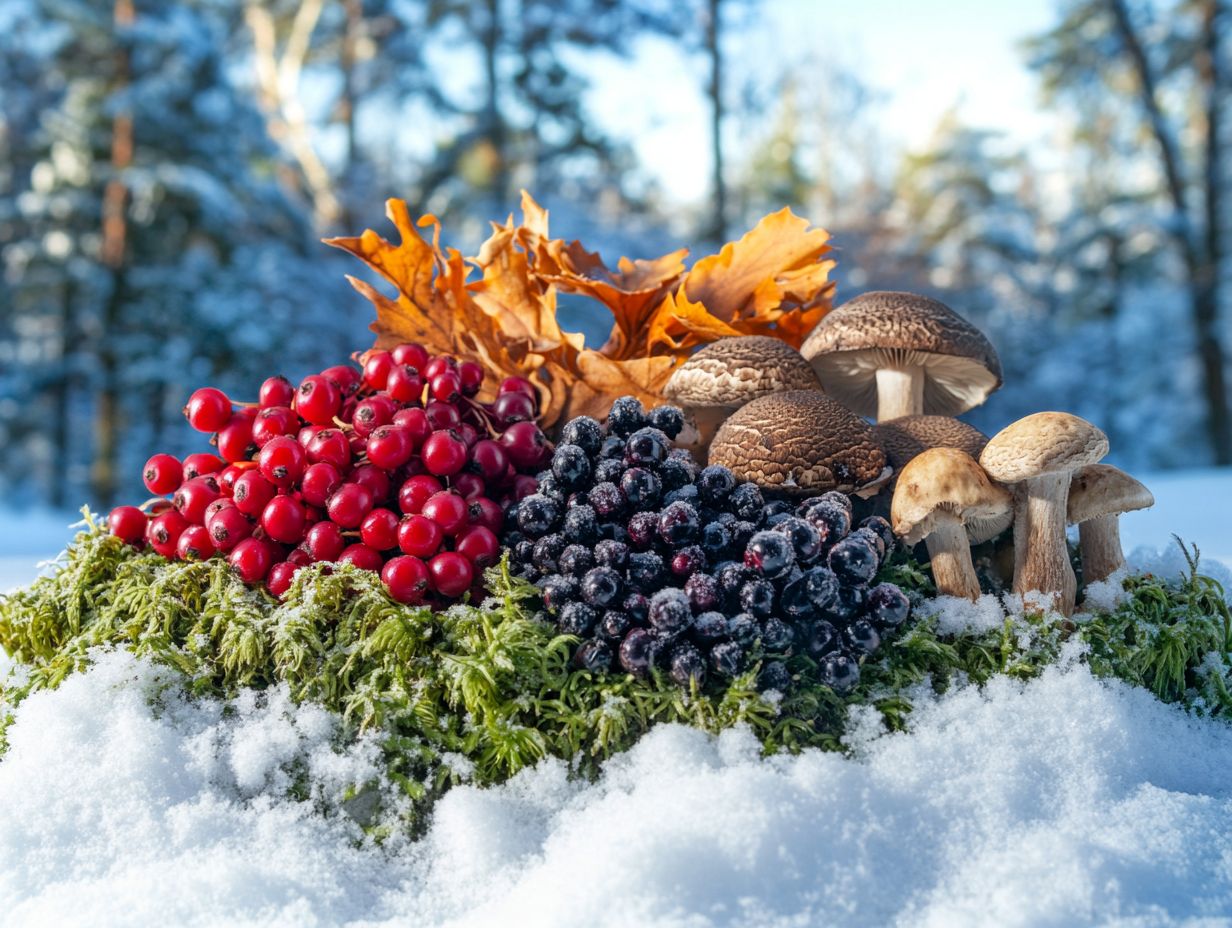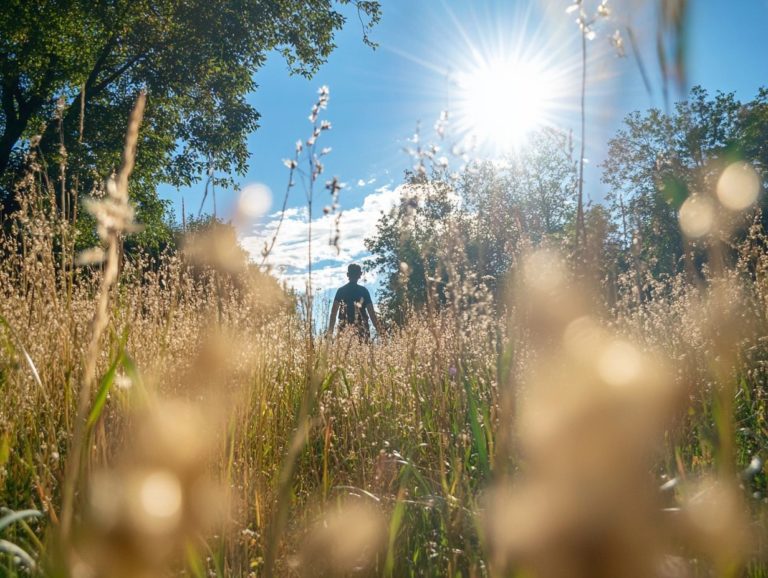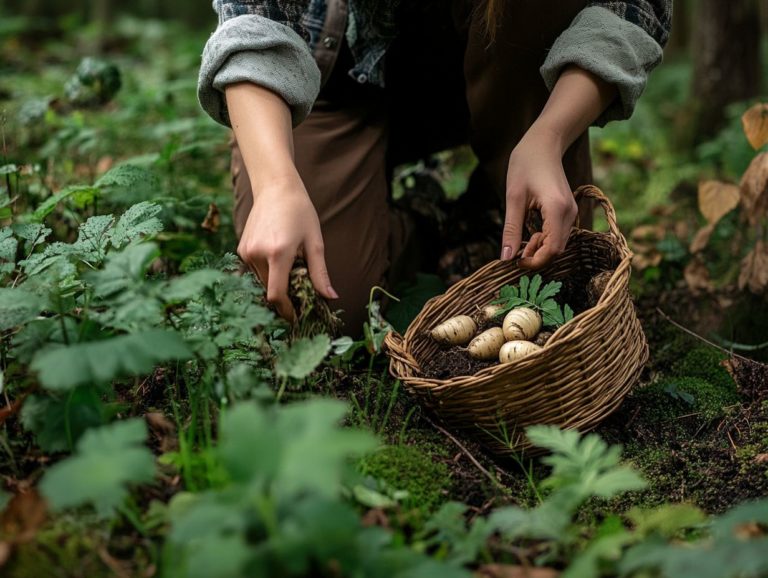Winter Foraging: 5 Edibles to Keep You Nourished
As the chill of winter envelops the landscape, it may appear desolate, yet hidden treasures lie in wait for those eager to explore. Winter foraging provides a wonderful opportunity to connect with nature while enhancing your diet with nutrient-rich edibles.
This article reveals five remarkable winter foraging finds from the vitamin C-packed rose hips to the immune-boosting elderberries.
You’ll also discover essential tips for foraging safely and sustainably, ensuring you make the most of nature s bounty during the colder months. Embrace this adventure and learn how to nourish your body with these seasonal gems!
Contents
- Key Takeaways:
- 1. Rose Hips: A Vitamin C Boost
- 2. Nettles: A Great Source of Nutrition
- 3. Pine Needles: A Source of Vitamins A and C
- 4. Dandelion Greens: A Versatile Foraging Option
- 5. Elderberries: A Natural Immune Booster
- How to Safely Forage for Winter Edibles
- Frequently Asked Questions
- What is winter foraging?
- Why should you try winter foraging?
- What delicious dishes can you make with foraged ingredients?
- Why is winter foraging important?
- What are some common edibles to forage for in winter?
- Are there any safety precautions to take when foraging in winter?
- What are the health benefits of foraging in winter?
- Can you forage for edibles in urban areas during winter?
Key Takeaways:

- Rose Hips: A natural and delicious way to boost your Vitamin C intake during the winter months.
- Dandelion Greens: A versatile and nutrient-rich option for winter foraging, perfect for salads or saut ing.
- Elderberries: A natural immune booster with high levels of antioxidants, perfect for preventing and fighting off colds and flu.
1. Rose Hips: A Vitamin C Boost
Rose hips are an extraordinary source of Vitamin C, offering a natural boost that becomes especially valuable during the winter months when fresh produce is scarce. For those who enjoy foraging for wild foods that enhance health, rose hips are a true treasure.
These small, round fruits, derived from the wild rose plant, are easily recognized by their striking red or orange hue, typically ripening from late summer to early fall. When you’re out foraging, aim to find plump, undamaged rose hips, as they signify peak ripeness and robust flavor.
Historically, rose hips served as a vital survival food, embraced by various cultures for their impressive nutrient profile, particularly during harsh winter conditions. You can prepare them in various ways, like drying them for tea or crafting delightful jams or syrups. Their versatility and health benefits make them an intriguing addition to any forager’s pantry.
2. Nettles: A Great Source of Nutrition
Stinging nettles are a great source of nutrition, providing vitamins and minerals that make them an excellent addition to your forager’s diet, especially if you’re keen on incorporating wild foods for improved health.
Packed with iron, calcium, and vitamins A and C, these versatile greens taste delicious and may also have anti-inflammatory properties that help alleviate allergies.
When handling nettles, remember to wear gloves to protect yourself from their sting, which arises from tiny hairs on the leaves. Cooking them is simple; a quick blanch or saut will transform these prickly plants into a delightful ingredient.
From savory soups to vibrant pesto, the culinary possibilities are vast, allowing you to savor their unique flavor while enjoying the nutritional benefits they offer.
3. Pine Needles: A Source of Vitamins A and C
Pine needles aren’t just a culinary curiosity; they re a delightful addition to teas and dishes, brimming with Vitamins A and C. Foraging for them from coniferous trees during winter can provide a remarkable nutritional boost when other food sources might be scarce.
When foraging, identifying the right type of pine tree is essential. Pay close attention to the needle characteristics note the length, color, and arrangement on the branch. For instance, the Eastern White Pine has long, soft needles that grow in clusters of five, while the Red Pine features shorter, sturdier needles arranged in pairs.
Once you ve harvested these vibrant green needles, steep them in hot water for aromatic teas or finely chop them to enhance baked goods like breads and muffins. They also work beautifully in infused oils, making a delightful addition to dressings or marinades, showcasing their versatility in flavor and health benefits.
4. Dandelion Greens: A Versatile Foraging Option

Dandelion greens are a versatile and nutrient-dense wild food. You can forage them in various seasons for unique flavors in salads, soups, and other dishes.
These vibrant leaves can be enjoyed cooked or raw. They bring a slightly bitter note that complements sweet or tangy ingredients beautifully.
Packed with vitamins A, C, and K, along with iron and calcium, they bolster your overall health and support immune function.
When foraging, it’s essential to identify dandelion greens by their distinctive jagged leaves and bright yellow flowers. Be sure to scout areas that are free from pesticides.
Understanding the differences between edible and inedible plants elevates your cooking experiences and equips you with vital survival skills. Knowing which wild plants to harvest can be crucial in a pinch.
5. Elderberries: A Natural Immune Booster
Elderberries are truly remarkable, known for their powerful immune-boosting properties. They make an essential part of winter foraging.
These small, dark berries are packed with antioxidants, vitamins A and C, and dietary fiber, all contributing to your overall well-being. Discover the magic of elderberries and their amazing health benefits!
To identify elderberries, look for their distinct clusters of small, round berries that flourish on shrubs, typically maturing from late summer through early autumn.
Exercise caution when harvesting only the fully ripe berries are safe to consume. Unripe berries and other parts of the plant can be toxic, so it s important to be informed.
Preparing elderberries safely means cooking them to neutralize harmful compounds. This allows you to create delicious recipes like syrups and jams that elevate both flavor and health.
For instance, crafting a simple elderberry syrup involves simmering the berries with water and sugar, resulting in a sweet elixir that is excellent for soothing coughs and colds.
How to Safely Forage for Winter Edibles
Foraging for winter edibles demands a blend of knowledge and skill, along with a sharp understanding of local flora. This ensures you re harvesting safe and nutrient-rich wild foods that can sustain you through the colder months while refining your survival skills.
It s vital to know which plants hold onto their nutritional value in winter. Start your foraging adventure by learning to identify these resilient species, paying close attention to their distinctive features even after the leaves have dropped.
Utilizing tools like a reliable field guide or a handy phone app can significantly enhance your foraging experience. Always try a small amount and wait for a few hours to see if you have any reactions.
Prioritizing safety is essential. Familiarize yourself with local regulations, steer clear of areas that may have been treated with pesticides, and when in doubt, consult an experienced forager before consuming anything.
What Are the Benefits of Foraging for Winter Edibles?
Foraging for winter edibles presents a multitude of benefits. This grants you access to fresh, nutrient-rich wild foods that can enhance your health, refine your survival skills, and deepen your connection with nature throughout the dreary winter months.
This time-honored practice supports a balanced diet bursting with vitamins and minerals and leads to substantial cost savings, as you gather free food from your local surroundings.
Experts consistently emphasize how these activities can invigorate both mind and body, transforming a simple outdoor excursion into a truly rewarding experience.
Consider a local forager who recalls a crisp January morning spent harvesting wild greens. She discovered that wandering through the silent woods nourished her spirit just as much as the foraged bounty would nourish her body.
Such experiences have the power to rekindle a sense of wonder and appreciation for the natural world. Embrace the adventure of foraging this winter, and unlock the gifts nature has to offer!
What Are the Risks of Foraging for Winter Edibles?

Foraging for winter edibles can be a rewarding endeavor. However, it s essential to recognize the potential risks involved. Misidentifying plants is a serious concern. This could lead to consuming toxic species that pose health hazards.
As you venture out in search of late-season foraging opportunities, be mindful of environmental challenges. These include slippery terrain, cold weather, and potential wildlife encounters. Such factors can significantly complicate your experience.
To mitigate these risks, always carry a reliable field guide to help you accurately identify edible plants. Foraging alongside a knowledgeable companion who can offer guidance and share their expertise is also a smart move.
Dressing appropriately for the weather and terrain is crucial. Additionally, inform someone of your plans before you head out. Taking these precautions can greatly enhance your safety during winter foraging adventures.
How Can One Incorporate Winter Foraging into Their Diet?
Incorporating winter foraging into your diet can be a delightful and nutritious adventure. Discovering wild greens and mushrooms can transform your meals! It ignites your creativity in meal preparation while offering a treasure trove of wild foods that enhance your overall health.
As you explore local landscapes and gather seasonal edibles like wild greens and mushrooms you not only reconnect with nature but also uncover unique flavors. These can elevate your everyday meals.
To seamlessly weave these foraged ingredients into your daily recipes, start with simple additions. Imagine tossing freshly foraged greens into your salads or soups.
Consider preparing a delicious wild mushroom risotto as a warming option that beautifully complements your usual pantry staples. This approach diversifies your diet and highlights the importance of blending wild finds with traditional groceries, ensuring your meals are wholesome and well-rounded.
What Are Some Common Misconceptions About Winter Foraging?
There are several common misconceptions about winter foraging. One of these is the belief that edible options dwindle during the colder months. This overlooks the rich tapestry of wild foods available for gathering in winter.
In reality, you’ll find that numerous strong plants grow well even in frosty temperatures. For instance, you can still harvest nutritious delights like stinging nettles, which thrive even after snowfalls. Don t forget about dandelion greens, celebrated for their vibrant nutritional profile. You might also stumble upon certain mushrooms, such as honey fungus, often concealed beneath a blanket of frost.
This season, armed with a bit of knowledge and the right techniques, you can unlock a treasure trove of natural resources. This challenges the conventional wisdom about winter s limitations on foraging.
How Can One Ensure They Are Foraging Ethically and Sustainably?
To ensure that your foraging practices are both ethical and sustainable, it s essential to follow best practices. These honor local ecosystems and support the health of wild plants. This ensures future generations can also enjoy these nutrient-rich resources.
Understanding the delicate balance within these environments is crucial. Take only what you need and avoid overharvesting. This allows plant populations to regenerate effectively. It s equally important to identify and avoid gathering endangered or threatened species. This not only protects biodiversity but also upholds the integrity of the ecosystem.
Utilizing tools that minimize soil disruption can significantly reduce your overall environmental impact. By educating yourself about local flora, you can avoid picking protected plants. This supports conservation efforts and cultivates responsible habits that benefit the earth.
Frequently Asked Questions

What is winter foraging?
Winter foraging is the practice of gathering edible plants and herbs during the winter season. It is an ancient survival skill that can provide nourishment and sustenance during the colder months.
Why should you try winter foraging?
Winter foraging can introduce you to new flavors and ingredients that you might not find in stores. It also encourages a deeper connection with nature and promotes sustainability.
What delicious dishes can you make with foraged ingredients?
You can create various dishes, such as wild mushroom risotto, fresh salads featuring foraged greens, or hearty soups with seasonal edibles. The possibilities are endless!
Ready to explore the winter woods? Grab your guide and start foraging today!
Why is winter foraging important?
Winter foraging is not just a hobby; it s an exciting way to connect with nature. It teaches us about plants and herbs that provide nutrition during the colder months.
What are some common edibles to forage for in winter?
Common edibles to forage for include wild berries, nuts, and roots. Look for wintergreens, mushrooms, and even tree bark.
Are there any safety precautions to take when foraging in winter?
Yes, be careful when foraging in winter. Identify all plants before consuming them, as some may be toxic.
Dress warmly and watch out for hazards like ice or slippery terrain.
What are the health benefits of foraging in winter?
Foraging in winter offers many health benefits. It gives you fresh air, exercise, and can even boost your vitamin intake.
Step outside this winter! Foraging can improve your mental clarity and promote a sense of well-being.
Can you forage for edibles in urban areas during winter?
Yes, you can forage for edibles in urban areas during winter. Check out community gardens, parks, and your own backyard for edible plants.
Just be sure to follow safety precautions and avoid areas that may be contaminated by pollution.


![Top 5 Foraging Locations in [Your Area] This Winter](https://forageadept.com/wp-content/uploads/2024/08/top-5-foraging-locations-in-your-area-this-winter-7a-768x578.jpeg)



